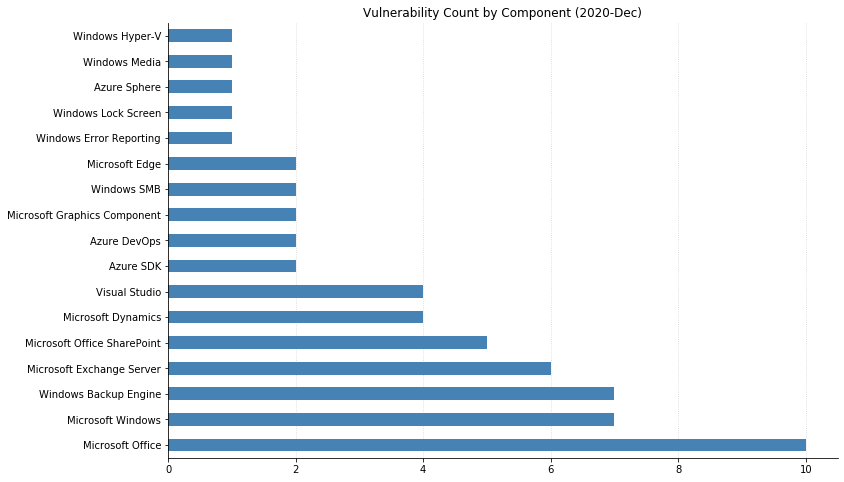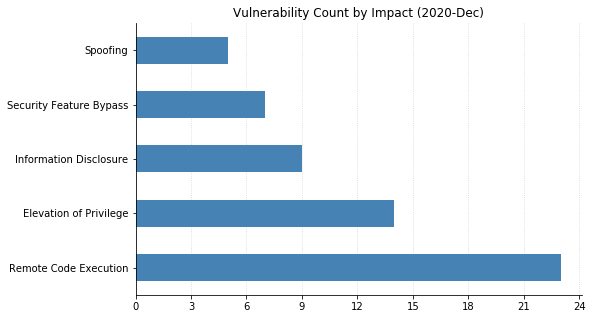Patch Tuesday – December 2020


We close off our 2020 year of Patch Tuesdays with 58 vulnerabilities being addressed. While it’s a higher count than our typical December months (high thirties), it’s still a nice breath of fresh air given how the past year has been. We do, however, get to celebrate that none of the reported vulnerabilities covered this month has been publicly exploited nor previously publicly disclosed and only 9 of the 58 vulnerabilities have been marked as Critical by Microsoft.
In terms of actionables, standard procedures can be followed here in terms of how to prioritize which sets of patches to apply first with two exceptions.
Microsoft Office vulnerabilities
A fair amount of remote code executions targeting Microsoft Excel are being patched up today and while none of them have the Preview Pane set as an attack vector, the volume of remote code execution vulnerabilities pertaining to Microsoft Office this month may suggest a slight re-jig of priorities. That’s our first (minor) exception.
The next exception is likely the most notable piece behind this December 2020 Patch Tuesday: Microsoft Exchange Server.
Microsoft Exchange Server vulnerabilities
While there are a total of six vulnerabilities from Microsoft Exchange Server this month, two of them garner a CVSS score of 9.1 (CVE-2020-17132, CVE-2020-17142) and one is noted by Microsoft has having a higher chance of exploitability (CVE-2020-17144). These three warrant an additional examination and may be grounds for prioritizing patching.
There is currently suspicion that CVE-2020-17132 helps address the patch bypass of CVE-2020-16875 (CVSS 8.4) from September 2020. As well, both CVE-2020-17132 and CVE-2020-17142 are remote code execution vulnerabilities occurring due to improper validation of cmdlet arguments that affect all supported (as of writing) versions of Microsoft Exchange. One important note to consider is while these vulnerabilities have received a CVSS score of 9.1 and do not require additional user interaction, an attacker must be in an authenticated role in order to exploit this vulnerability.
In contrast, CVE-2020-17144 which is another remote code execution vulnerability also stemming from improper validation for cmdlet arguments, this one only affects Exchange Server 2010 SP3 and does require additional user interaction to successfully execute. This is extra interesting as Microsoft Exchange Server 2010 passed end of life back on October 22, 2020. The introduction of this post-EOL patch for Microsoft Exchange Server 2010 coupled with Microsoft noting this vulnerability to be more likely exploitable does suggest prioritizing this patch a bit earlier.
New Summary Tables
In an attempt to provide a bit more summarizing tables, here are this month’s patched vulnerabilities split by the product family.
Azure Vulnerabilities
| CVE | Vulnerability Title | Exploited | Disclosed | CVSS3 | has_faq |
|---|---|---|---|---|---|
| CVE-2020-17160 | Azure Sphere Security Feature Bypass Vulnerability | False | False | 7.4 | True |
| CVE-2020-16971 | Azure SDK for Java Security Feature Bypass Vulnerability | False | False | 7.4 | False |
Browser Vulnerabilities
| CVE | Vulnerability Title | Exploited | Disclosed | CVSS3 | has_faq |
|---|---|---|---|---|---|
| CVE-2020-17153 | Microsoft Edge for Android Spoofing Vulnerability | False | False | 4.3 | True |
| CVE-2020-17131 | Chakra Scripting Engine Memory Corruption Vulnerability | False | False | 4.2 | False |
Developer Tools Vulnerabilities
| CVE | Vulnerability Title | Exploited | Disclosed | CVSS3 | has_faq |
|---|---|---|---|---|---|
| CVE-2020-17148 | Visual Studio Code Remote Development Extension Remote Code Execution Vulnerability | False | False | 7.8 | True |
| CVE-2020-17150 | Visual Studio Code Remote Code Execution Vulnerability | False | False | 7.8 | False |
| CVE-2020-17156 | Visual Studio Remote Code Execution Vulnerability | False | False | 7.8 | True |
| CVE-2020-17159 | Visual Studio Code Java Extension Pack Remote Code Execution Vulnerability | False | False | 7.8 | False |
| CVE-2020-17002 | Azure SDK for C Security Feature Bypass Vulnerability | False | False | 7.4 | False |
| CVE-2020-17135 | Azure DevOps Server Spoofing Vulnerability | False | False | 6.4 | False |
| CVE-2020-17145 | Azure DevOps Server and Team Foundation Services Spoofing Vulnerability | False | False | 5.4 | False |
ESU Windows Vulnerabilities
| CVE | Vulnerability Title | Exploited | Disclosed | CVSS3 | has_faq |
|---|---|---|---|---|---|
| CVE-2020-17140 | Windows SMB Information Disclosure Vulnerability | False | False | 8.1 | True |
| CVE-2020-16958 | Windows Backup Engine Elevation of Privilege Vulnerability | False | False | 7.8 | False |
| CVE-2020-16959 | Windows Backup Engine Elevation of Privilege Vulnerability | False | False | 7.8 | False |
| CVE-2020-16960 | Windows Backup Engine Elevation of Privilege Vulnerability | False | False | 7.8 | False |
| CVE-2020-16961 | Windows Backup Engine Elevation of Privilege Vulnerability | False | False | 7.8 | False |
| CVE-2020-16962 | Windows Backup Engine Elevation of Privilege Vulnerability | False | False | 7.8 | False |
| CVE-2020-16963 | Windows Backup Engine Elevation of Privilege Vulnerability | False | False | 7.8 | False |
| CVE-2020-16964 | Windows Backup Engine Elevation of Privilege Vulnerability | False | False | 7.8 | False |
| CVE-2020-17098 | Windows GDI+ Information Disclosure Vulnerability | False | False | 5.5 | True |
Exchange Server Vulnerabilities
| CVE | Vulnerability Title | Exploited | Disclosed | CVSS3 | has_faq |
|---|---|---|---|---|---|
| CVE-2020-17132 | Microsoft Exchange Remote Code Execution Vulnerability | False | False | 9.1 | True |
| CVE-2020-17142 | Microsoft Exchange Remote Code Execution Vulnerability | False | False | 9.1 | True |
| CVE-2020-17143 | Microsoft Exchange Information Disclosure Vulnerability | False | False | 8.8 | True |
| CVE-2020-17141 | Microsoft Exchange Remote Code Execution Vulnerability | False | False | 8.4 | True |
| CVE-2020-17144 | Microsoft Exchange Remote Code Execution Vulnerability | False | False | 8.4 | True |
| CVE-2020-17117 | Microsoft Exchange Remote Code Execution Vulnerability | False | False | 6.6 | False |
Microsoft Dynamics Vulnerabilities
| CVE | Vulnerability Title | Exploited | Disclosed | CVSS3 | has_faq |
|---|---|---|---|---|---|
| CVE-2020-17152 | Microsoft Dynamics 365 for Finance and Operations (on-premises) Remote Code Execution Vulnerability | False | False | 8.8 | True |
| CVE-2020-17158 | Microsoft Dynamics 365 for Finance and Operations (on-premises) Remote Code Execution Vulnerability | False | False | 8.8 | True |
| CVE-2020-17147 | Dynamics CRM Webclient Cross-site Scripting Vulnerability | False | False | 8.7 | True |
| CVE-2020-17133 | Microsoft Dynamics Business Central/NAV Information Disclosure | False | False | 6.5 | True |
Microsoft Office Vulnerabilities
| CVE | Vulnerability Title | Exploited | Disclosed | CVSS3 | has_faq |
|---|---|---|---|---|---|
| CVE-2020-17121 | Microsoft SharePoint Remote Code Execution Vulnerability | False | False | 8.8 | True |
| CVE-2020-17118 | Microsoft SharePoint Remote Code Execution Vulnerability | False | False | 8.1 | False |
| CVE-2020-17115 | Microsoft SharePoint Spoofing Vulnerability | False | False | 8 | True |
| CVE-2020-17122 | Microsoft Excel Remote Code Execution Vulnerability | False | False | 7.8 | True |
| CVE-2020-17123 | Microsoft Excel Remote Code Execution Vulnerability | False | False | 7.8 | True |
| CVE-2020-17124 | Microsoft PowerPoint Remote Code Execution Vulnerability | False | False | 7.8 | True |
| CVE-2020-17125 | Microsoft Excel Remote Code Execution Vulnerability | False | False | 7.8 | True |
| CVE-2020-17127 | Microsoft Excel Remote Code Execution Vulnerability | False | False | 7.8 | True |
| CVE-2020-17128 | Microsoft Excel Remote Code Execution Vulnerability | False | False | 7.8 | True |
| CVE-2020-17129 | Microsoft Excel Remote Code Execution Vulnerability | False | False | 7.8 | True |
| CVE-2020-17089 | Microsoft SharePoint Elevation of Privilege Vulnerability | False | False | 7.1 | False |
| CVE-2020-17119 | Microsoft Outlook Information Disclosure Vulnerability | False | False | 6.5 | True |
| CVE-2020-17130 | Microsoft Excel Security Feature Bypass Vulnerability | False | False | 6.5 | True |
| CVE-2020-17126 | Microsoft Excel Information Disclosure Vulnerability | False | False | 5.5 | True |
| CVE-2020-17120 | Microsoft SharePoint Information Disclosure Vulnerability | False | False | 5.3 | True |
Windows Vulnerabilities
| CVE | Vulnerability Title | Exploited | Disclosed | CVSS3 | has_faq |
|---|---|---|---|---|---|
| CVE-2020-17095 | Hyper-V Remote Code Execution Vulnerability | False | False | 8.5 | True |
| CVE-2020-17092 | Windows Network Connections Service Elevation of Privilege Vulnerability | False | False | 7.8 | False |
| CVE-2020-17134 | Windows Cloud Files Mini Filter Driver Elevation of Privilege Vulnerability | False | False | 7.8 | False |
| CVE-2020-17136 | Windows Cloud Files Mini Filter Driver Elevation of Privilege Vulnerability | False | False | 7.8 | False |
| CVE-2020-17137 | DirectX Graphics Kernel Elevation of Privilege Vulnerability | False | False | 7.8 | False |
| CVE-2020-17139 | Windows Overlay Filter Security Feature Bypass Vulnerability | False | False | 7.8 | False |
| CVE-2020-17096 | Windows NTFS Remote Code Execution Vulnerability | False | False | 7.5 | True |
| CVE-2020-17103 | Windows Cloud Files Mini Filter Driver Elevation of Privilege Vulnerability | False | False | 7 | False |
| CVE-2020-17099 | Windows Lock Screen Security Feature Bypass Vulnerability | False | False | 6.8 | True |
| CVE-2020-16996 | Kerberos Security Feature Bypass Vulnerability | False | False | 6.5 | True |
| CVE-2020-17094 | Windows Error Reporting Information Disclosure Vulnerability | False | False | 5.5 | True |
| CVE-2020-17138 | Windows Error Reporting Information Disclosure Vulnerability | False | False | 5.5 | True |
| CVE-2020-17097 | Windows Digital Media Receiver Elevation of Privilege Vulnerability | False | False | 3.3 | False |
Summary Graphs








If you like the site, please consider joining the telegram channel or supporting us on Patreon using the button below.


![[QILIN] - Ransomware Victim: Zimmerman & Frachtman PA Law Firm 8 image](https://www.redpacketsecurity.com/wp-content/uploads/2024/09/image-300x300.png)

